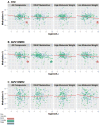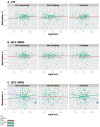The impact of first trimester phthalate and phenol exposure on IGF2/H19 genomic imprinting and birth outcomes
- PMID: 24972507
- PMCID: PMC4155603
- DOI: 10.1016/j.envres.2014.04.032
The impact of first trimester phthalate and phenol exposure on IGF2/H19 genomic imprinting and birth outcomes
Abstract
Genomic imprinting leads to parent-of-origin specific gene expression and is determined by epigenetic modification of genes. The paternally expressed gene insulin-like growth-factor 2 (IGF2) is located about ~100kb from the maternally expressed non-coding gene H19 on human chromosome 11, and both genes play major roles in embryonic and placental growth. Given adverse gestational environments can influence DNA methylation patterns in extra-embryonic tissues, we hypothesized that prenatal exposure to endocrine disrupting chemicals (EDCs) alters H19 and IGF2 methylation in placenta. Our study was restricted to a total of 196 women co-enrolled in the Predictors of Preeclampsia Study and the Harvard Epigenetic Birth Cohort. First trimester urine concentrations of 8 phenols and 11 phthalate metabolites were measured and used to characterize EDC exposure profiles. We assessed methylation of differentially methylated regions (DMRs) by pyrosequencing of H19, IGF2DMR0, and IGF2DMR2 and correlated values with phenol and phthalate metabolites. We also assessed overall expression and allele-specific expression of H19 and IGF2. We found several significant associations between DNA methylation and additive biomarker measurements. A significant decrease in H19 methylation was associated with high levels of the sum (Σ) of phthalate metabolites and metabolites of low molecular weight (LMW) phthalates. Σphthalate and LMW phthalate concentrations were inversely associated with IGF2DMR0 methylation values. Variation in methylation was not associated with changes in allele-specific expression. However increased deviation of allele-specific expression of H19 was associated with Σdi(2-ethylhexyl) phthalate metabolites and high molecular weight phthalates. Neither methylation nor expression of these imprinted regions had a significant impact on birth length or birth weight. Overall, our study provides new insight into an epigenetic mechanism that occurs following EDC exposure.
Keywords: Allele-specific expression; Endocrine disruptors; Epidemiology; Imprinting; Methylation.
Copyright © 2014 Elsevier Inc. All rights reserved.
Figures



Similar articles
-
Quantitative allele-specific expression and DNA methylation analysis of H19, IGF2 and IGF2R in the human placenta across gestation reveals H19 imprinting plasticity.PLoS One. 2012;7(12):e51210. doi: 10.1371/journal.pone.0051210. Epub 2012 Dec 5. PLoS One. 2012. PMID: 23227253 Free PMC article.
-
Maternal levels of endocrine disrupting chemicals in the first trimester of pregnancy are associated with infant cord blood DNA methylation.Epigenetics. 2018;13(3):301-309. doi: 10.1080/15592294.2018.1448680. Epub 2018 Apr 18. Epigenetics. 2018. PMID: 29513082 Free PMC article.
-
First-Trimester Urine Concentrations of Phthalate Metabolites and Phenols and Placenta miRNA Expression in a Cohort of U.S. Women.Environ Health Perspect. 2016 Mar;124(3):380-7. doi: 10.1289/ehp.1408409. Epub 2015 Jun 19. Environ Health Perspect. 2016. PMID: 26090578 Free PMC article.
-
Involvement of IGF2 and H19 imprinting in choriocarcinoma development.Int J Gynaecol Obstet. 1998 Apr;60 Suppl 1:S1-8. Int J Gynaecol Obstet. 1998. PMID: 9833609 Review.
-
Igf2-H19, an imprinted tandem gene, is an important regulator of embryonic development, a guardian of proliferation of adult pluripotent stem cells, a regulator of longevity, and a 'passkey' to cancerogenesis.Folia Histochem Cytobiol. 2012 Jul 5;50(2):171-9. doi: 10.5603/fhc.2012.0026. Folia Histochem Cytobiol. 2012. PMID: 22763974 Review.
Cited by
-
Effects of prenatal perfluoroalkyl acid exposure on cord blood IGF2/H19 methylation and ponderal index: The Hokkaido Study.J Expo Sci Environ Epidemiol. 2017 May;27(3):251-259. doi: 10.1038/jes.2016.50. Epub 2016 Aug 24. J Expo Sci Environ Epidemiol. 2017. PMID: 27553991
-
Transcriptomic profiling of PBDE-exposed HepaRG cells unveils critical lncRNA- PCG pairs involved in intermediary metabolism.PLoS One. 2020 Feb 26;15(2):e0224644. doi: 10.1371/journal.pone.0224644. eCollection 2020. PLoS One. 2020. PMID: 32101552 Free PMC article.
-
Integrative Analysis of Gene-Specific DNA Methylation and Untargeted Metabolomics Data from the ELEMENT Cohort.Epigenet Insights. 2020 Dec 10;13:2516865720977888. doi: 10.1177/2516865720977888. eCollection 2020. Epigenet Insights. 2020. PMID: 33354655 Free PMC article.
-
First trimester mechanisms of gestational sac placental and foetal teratogenicity: a framework for birth cohort studies.Hum Reprod Update. 2021 Jun 22;27(4):747-770. doi: 10.1093/humupd/dmaa063. Hum Reprod Update. 2021. PMID: 33675653 Free PMC article. Review.
-
DNA methylation of imprinted genes in Mexican-American newborn children with prenatal phthalate exposure.Epigenomics. 2018 Jul;10(7):1011-1026. doi: 10.2217/epi-2017-0178. Epub 2018 Jun 29. Epigenomics. 2018. PMID: 29957030 Free PMC article.
References
-
- Barker DJ. Maternal nutrition, fetal nutrition, and disease in later life. Nutrition. 1997;13(9):807–813. - PubMed
-
- Roseboom TJ, Painter RC, van Abeelen AF, Veenendaal MV, de Rooij SR. Hungry in the womb: what are the consequences? Lessons from the Dutch famine. Maturitas. 2011;70(2):141–145. - PubMed
Publication types
MeSH terms
Substances
Grants and funding
LinkOut - more resources
Full Text Sources
Other Literature Sources
Miscellaneous

